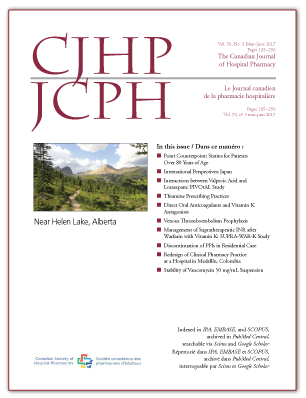Pharmacokinetic Interactions between Valproic Acid and Lorazepam (PIVOtAL Study): A Review of Site-Specific Practices
DOI:
https://doi.org/10.4212/cjhp.v70i3.1656Keywords:
valproic acid, lorazepam, pharmacokinetics, drug-drug interaction, uridine 5′-diphosphate-glucuronosyltransferases, acide valproïque, lorazépam, pharmacocinétique, interaction médicament-médicament, uridine 5’-diphosphate glucuronosyltransférasesAbstract
ABSTRACT
Background: Coadministration of lorazepam and valproic acid is identified by tertiary references as causing a major drug interaction that requires therapy modification and dosage adjustments. The proposed mechanism involves inhibition of lorazepam glucuronidation via direct inhibition of uridine 5′-diphosphate-glucuronosyltransferase enzymes by valproic acid. However, the clinical significance of this interaction is unclear.
Objectives: To identify site-specific practices and assess clinical responses to the interaction between valproic acid and lorazepam.
Methods: A chart review was conducted for patients over 18 years of age who were admitted, from September 2008 to September 2014 inclusive, to the psychiatry or neurology service at Vancouver General Hospital, Vancouver, British Columbia, and who received concomitant valproic acid and lorazepam therapy.
Results: Of the 30 patients included in the chart review, 12 (40%) received an intervention. A total of 8 (27%) patients experienced an adverse drug reaction (ADR), such as drowsiness and dizziness. Seven of these 8 patients were among those who received an intervention. The mean dosage (± standard deviation) of lorazepam was 4.2 ± 1.2 mg per day among patients who experienced an ADR and less than 2 mg per day among those who did not experience an ADR.
Conclusions: The current recommendation from tertiary drug references is to reduce the dose of lorazepam by 50% when this drug is coadministered with valproic acid. However, this recommendation could not be validated through an analysis of patients exposed to this interaction in the clinical setting or through a review of the literature. Further clinical and pharmacokinetic studies are required to determine whether concurrent treatment with lorazepam and valproic acid should be considered as causing a major drug interaction. Until more data are available, clinicians should remain cognizant of the potential for a drug–drug interaction and should use the lowest effective dose of lorazepam when this drug is administered concomitantly with valproic acid.
RÉSUMÉ
Contexte : Selon des sources tertiaires, la prise concomitante de lorazépam et d’acide valproïque causerait une interaction médicamenteuse grave nécessitant un changement au traitement et des ajustements posologiques. Le mécanisme qui sous-tend cette interaction est l’inhibition de la glucuronoconjugaison du lorazépam au moyen de l’inhibition directe des enzymes uridine 5’-diphosphate glucuronosyltransférases par l’acide valproïque. Cependant, la signification clinique de cette interaction est inconnue.
Objectifs : Déterminer quelles sont les pratiques particulières à l’établissement hospitalier et évaluer les réponses cliniques à l’interaction entre l’acide valproïque et le lorazépam.
Méthodes : On a mené une analyse des dossiers médicaux des patients de plus de 18 ans qui, entre septembre 2008 et septembre 2014 inclusivement, ont été admis au service de psychiatrie ou de neurologie de l’Hôpital général de Vancouver, à Vancouver en Colombie-Britannique, et ont reçu en même temps l’acide valproïque et le lorazépam.
Résultats : Parmi les 30 patients dont le dossier médical a été retenu pour l’analyse, 12 (40 %) ont eu droit à une intervention. Un total de 8 (27 %) patients ont subi une réaction indésirable aux médicaments (RIM), comme de la somnolence et des étourdissements. Sept de ces 8 patients appartenaient au groupe qui a eu droit à une intervention. La dose quotidienne moyenne de lorazépam était de 4,2 ± 1,2 mg chez les patients qui ont subi une RIM et de moins de 2 mg chez ceux qui n’en ont pas subi.
Conclusions : Des sources tertiaires sur les médicaments recommandent actuellement de réduire la dose de lorazépam de 50 % lorsque ce médicament est administré conjointement avec l’acide valproïque. Or, cette recommandation n’a pu être validée à l’aide d’une revue de la littérature ou d’une analyse des dossiers des patients ayant été exposés à une telle interaction médicamenteuse en milieu clinique. De plus amples études cliniques et pharmacocinétiques sont nécessaires pour déterminer si la prise concomitante de lorazépam et d’acide valproïque peut être considérée comme une cause d’interaction médicamenteuse grave. D’ici à ce qu’ils disposent de plus de données probantes, les cliniciens doivent demeurer conscients du potentiel d’interaction médicament-médicament et utiliser la plus faible dose efficace de lorazépam lorsque ce médicament est pris en concomitance avec l’acide valproïque.
Downloads
Published
Issue
Section
License
Copyright © Canadian Society of Healthcare-Systems Pharmacy.
After publication of a manuscript in the CJHP, the authors of the manuscript must obtain written permission from the CSHP (publications@cshp.ca) before reproducing any text, figures, tables, or illustrations from the work in future works of their own. If a submitted manuscript is declined for publication in the CJHP, all said rights shall revert to the authors. Please note that any forms (e.g., preprinted orders and patient intake forms) used by a specific hospital or other health care facility and included as illustrative material with a manuscript are exempt from this copyright transfer. The CJHP will require a letter from the hospital or health care facility granting permission to publish the document(s).










